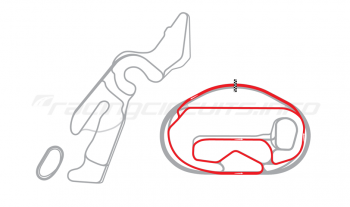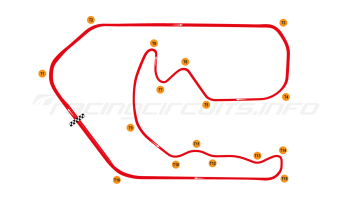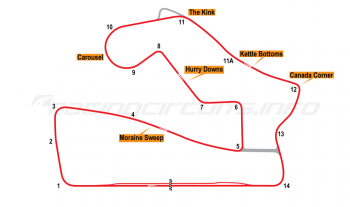Las Vizcachas
Circuit Overview
The Autódromo de Las Vizcachas has a long history of motorsport, including some of the most dramatic moments in Chilean racing history.
Truncated in half by rapid urban expansion, today the circuit is heavily noise restricted and hosts little motorsport but remains in use for track day and driver training operations.
Circuit History
Located in the suburban municipality of Puente Alto, on the edge of Chile's capital city, Santiago, the circuit opened on October 5, 1965. With the Andes forming a dramatic backdrop, the 3km circuit boasted a long main straight in front of a hillside spectator area, which offered panoramic views of the whole course. A shorter loop of just less than one mile was also offered, alongside a slightly extended variant and a quarter mile oval.
From the outset it proved a popular venue and over the years played host to national championships for Formula 4 and Formula 3 machinery, as well as becoming a fixture on the Codasur F2 calendar. The greats of Chilean racing all cut their teeth here; Eliseo Salazar, Giuseppe Bacigalupo and Juan Gac all were regulars here.
The track suffered a tragedy in 1975, when seven spectators and officials were killed and numerous others injured when the cars of Eduardo Kovacs and Roberto Gómez Barrios tangled on the main straight and careered into the unprotected pit area. In the aftermath, Kovacs – a former Chilean champion – was roundly and unfairly criticised in the media as being responsible for the catastrophe, causing him to quit racing altogether. In truth, lax circuit safety was the real culprit, through Las Vizcachas was not unusual in those days of not having a retaining wall. The circuit closed for the 1976 season and when it reopened the following year, a new wall lined the pit area.
Racing settled back to normality, but another tragedy was to befall the circuit a decade later at the same spot. On September 26, 1987, during a Formula 3 race, former national champion Sergio Santander was making his way back through the field after an early spin on oil when he tangled with competitor Gonzalo Alcalde on the main straight. The two cars interlocked and speared off the course and straight into the retaining wall – ironically the same wall introduced after the 1975 tragedy. The impact was fearsome, shaking the foundations of the circuit control tower immediately behind it. After a 35 minute battled to free Santander from the wreckage, he was transported to hospital by helicopter but succumbed to his injuries en route.
It was a bleak day for Chilean motorsport, made the worse for having been captured on live television for the whole country to see. The sad event marked the beginning of a decline of activity at the track as fans began to question their love of the sport, realising first hand its dangers.
As audiences declined, so too another threat emerged; the expanding urban sprawl of Santiago. By the early 1990s, condominiums for the well-to-do began to edge their way ever closer to the circuit. Where it had once been in open countryside, now the track found itself a part of the suburbs. As many other circuits have found to their cost, complaints over noise began to increase, while the value of the land on which the track lay also rose as housing developers circled.
In 1992, a decision was made to sell off the eastern half of the land for housing, leading to the track being truncated halfway along its main straight. A large earth bank was built to try and conceal the noise and a new extension built inside the original short course to give a lap length of just under 1.4 miles. Racing continued but the clock was surely ticking.
By 2006, the organising Club de Automovilismo Carrozado reluctantly flew the white flag and declared that it would be the last season of racing. After a calendar of featuring 10 different categories on four and two wheels, including the ever popular F3, the final chequered flag seemingly flew in December.
For the next few years the circuit fell largely silent, with only occasional (and heavily silenced) club races. It was somewhat unexpected therefore when, in 2012, the organisers of the Formula 3 races announced they were returning to the circuit. Noise restrictors would allow the racing to go ahead, according to the category organisers. However, a few weeks before the event the local motor club retracted the agreement to race, citing the noise restrictions and damage to the track caused by an earlier machinery festival held on the site.
Nevertheless, the circuit still appears to run a small number of club competitions and track days, where cars presumably run heavily silenced. Quite how sustainable this is in the long run is anyone's guess and it would be no surprise if Las Vizcachas quietly faded away altogether.
Jump onboard
Circuit info
- Autódromo de Las Vizcachas, Camino San José de Maipo 05669, Puente Alto, Santiago de Chile, Chile
Rate This Circuit
Votes: 4879
Plan a visit
Get your race tickets!
Brought to you with: 
We've teamed up with Motorsports Tickets to bring you the best deals for Formula One, MotoGP, Le Mans and more.

















